
Date: July 19, 2021
Location: Lat: 36.348062°, Lon: -59.118589°
Dive depth range: 1,993 - 2,144 meters (6,539 - 6,936 feet)
Access Dive Summary and ROV Data
“Seven” Seamount was explored on Dive 14 of the 2021 North Atlantic Stepping Stones expedition. The team nicknamed the seamount “Seven” because it was the seventh seamount of the expedition that had not previously been mapped or visually surveyed. As the first “eyes on the ground” at these seamounts, we are seeing things no person has ever seen before and increasing our understanding of our largely unknown ocean. Video courtesy of NOAA Ocean Exploration, 2021 North Atlantic Stepping Stones: New England and Corner Rise Seamounts. Download largest version (mp4, 72.2 MB).
For Dive 14 of the 2021 North Atlantic Stepping Stones expedition, we explored “Seven” Seamount, so (unofficially) named because it was the seventh seamount of this expedition that, prior to our arrival, had never been mapped or visually surveyed.
The dive began on ferromanganese-encrusted pavements with botryoidal textures (grape-like). As the dive progressed, the pavement showed a number of lava-flow ridges (pillow lava morphology) and debris aprons/chutes. As the slope gradient increased, the seafloor morphology shifted to a series of steep, near-vertical walls and benches dominated by ferromanganese-encrusted pillow lava. Towards the end of the dive, the ferromanganese crust became smooth, suggestive of varying current velocities.
This area was a highly biodiverse community dominated by a wide variety of fish, sea stars, sponges, and corals - including a potentially new bamboo coral morphotype. Throughout the dive transect, we observed thick coral and sponge debris layers covering every crack and crevice of the variable volcanic substrates. This coral debris also showed numerous fossil coral skeletons with dark ferromanganese coatings and structures suggestive of some level of cementation.
This shrimp was seen swimming in the water column during Dive 14 of the 2021 North Atlantic Stepping Stones, at a depth of 2,130 meters (6,990 feet).Video courtesy of NOAA Ocean Exploration, 2021 North Atlantic Stepping Stones: New England and Corner Rise Seamounts. Download largest version (mp4, 54.6 MB).
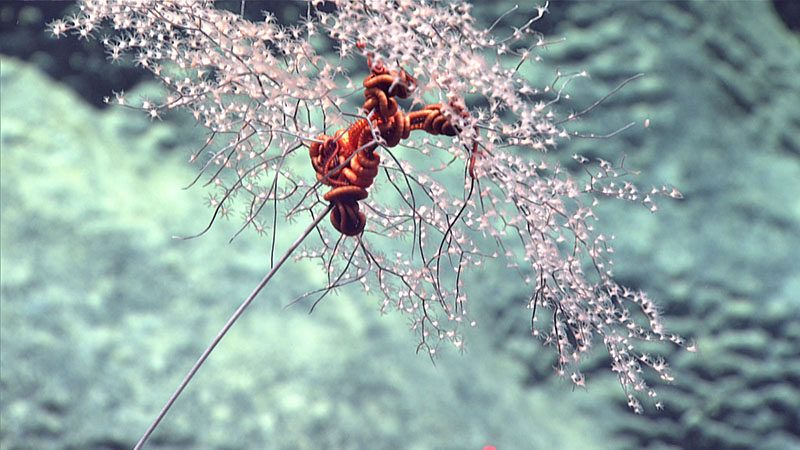
The first Metallogorgia sp. seen on Dive 14 of the 2021 North Atlantic Stepping Stones expedition, at 2,101 meters (6,893 feet). This is a mature Metallogorgia sp. as indicated by the single stalk and the living polyps at the top, forming an umbrella-like structure. Juveniles possess multiple branches throughout the stalk. At the center of the umbrella structure is a brittle star with its arms tightly coiled around the Metallogorgia sp. Image courtesy of NOAA Ocean Exploration, 2021 North Atlantic Stepping Stones: New England and Corner Rise Seamounts. Download largest version (jpg, 1.1 MB).
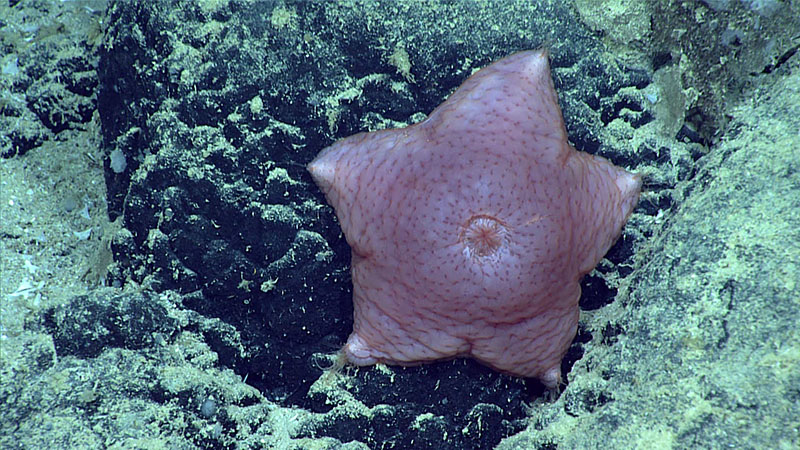
We observed several species of slime stars during Dive 14 of the 2021 North Atlantic Stepping Stones expedition, including this Pteraster sp. This slime star was measured to be over 10 centimeters (4 inches) in size and was observed at 2,133 meters (6,998 feet). Slime stars are recognizable by having a central opening with an outer covering. Image courtesy of NOAA Ocean Exploration, 2021 North Atlantic Stepping Stones: New England and Corner Rise Seamounts. Download largest version (jpg, 1.7 MB).
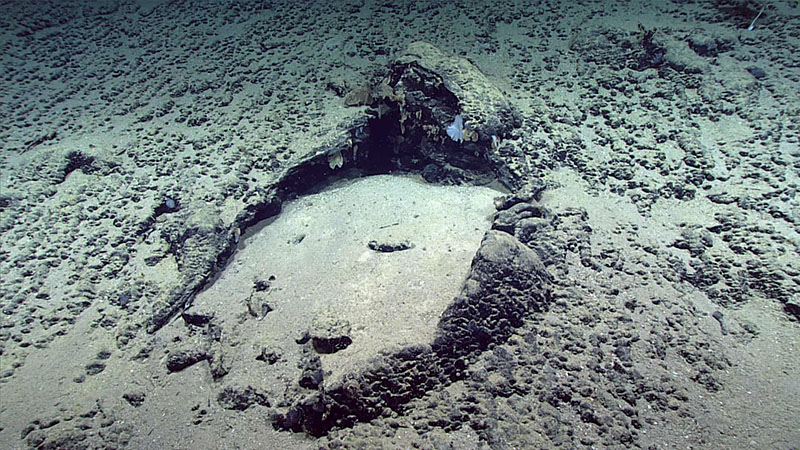
Progressing upslope from the landing area, we encountered a sediment-filled collapsed pillow, which was one of just a few “outcrops” on the broad low-relief pavement. This site yielded the only rock sample of Dive 14 of the 2021 North Atlantic Stepping Stones expedition. Image courtesy of NOAA Ocean Exploration, 2021 North Atlantic Stepping Stones: New England and Corner Rise Seamounts. Download largest version (jpg, 1.7 MB).
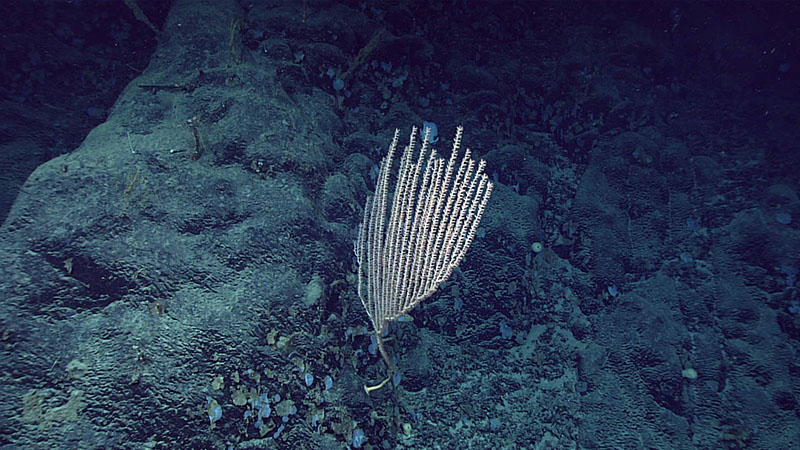
Deep-sea corals, and particularly bamboo corals, were abundant throughout Dive 14 of the 2021 North Atlantic Stepping Stones expedition. This particular bamboo coral has a distinct candelabra shape and was seen at 2,065 meters (6,775 feet). One of these candelabra bamboo corals was sampled on this dive for future investigation as a potentially new morphotype. Image courtesy of NOAA Ocean Exploration, 2021 North Atlantic Stepping Stones: New England and Corner Rise Seamounts. Download largest version (jpg, 1.4 MB).
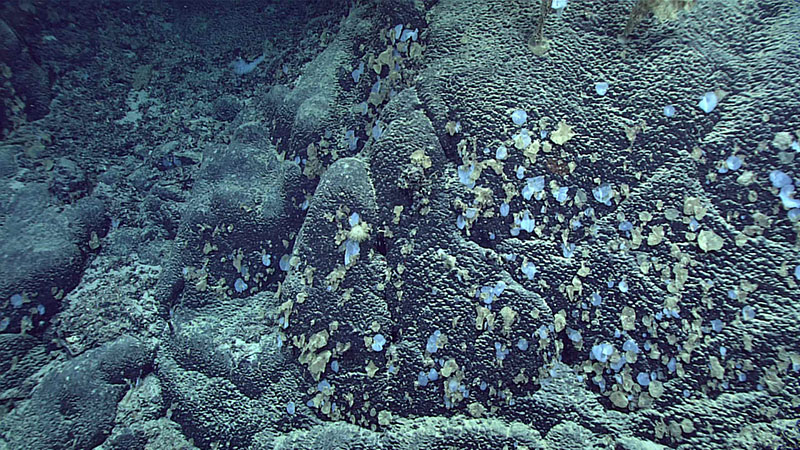
Dive 14 of the 2021 North Atlantic Stepping Stones expedition was dominated by sponges encrusting the sides of pillow lava rocks, both dead (brown) and live (white). These sponges were most commonly Euretidae sp. and occurred throughout the entire dive transect. Other sponge genera we encountered on this dive include yellow Hertwigia, white Aphrocallistes, and Polymastia, as well as other unknown species. Image courtesy of NOAA Ocean Exploration, 2021 North Atlantic Stepping Stones: New England and Corner Rise Seamounts. Download largest version (jpg, 2 MB).

Location of Dive 14 of the 2021 North Atlantic Stepping Stones expedition on July 19, 2021. Map courtesy of NOAA Ocean Exploration, 2021 North Atlantic Stepping Stones: New England and Corner Rise Seamounts. Download largest version (jpg, 3 MB).
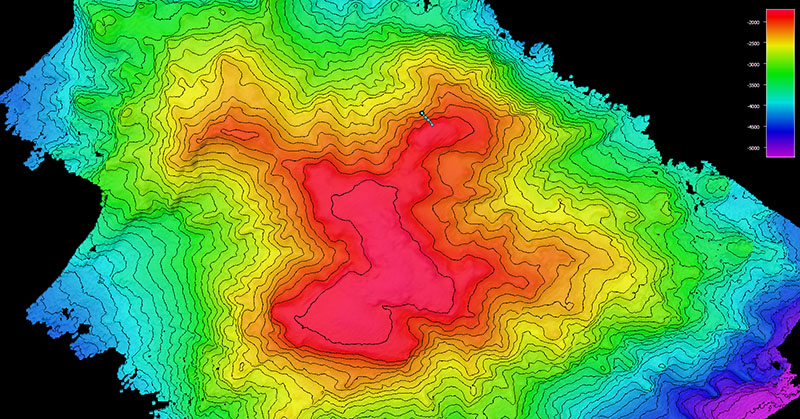
Image showing the dive track of Dive 14 of the 2021 North Atlantic Stepping Stones expedition. Scale is water depth in meters. Image courtesy of NOAA Ocean Exploration, 2021 North Atlantic Stepping Stones: New England and Corner Rise Seamounts. Download largest version (jpg, 2.1 MB).